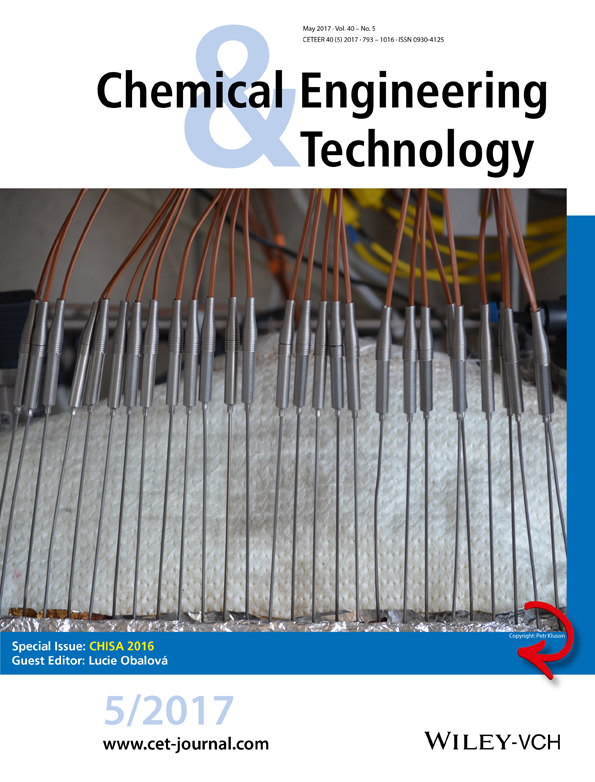Evaluation of Benzylamine Production via Reductive Amination of Benzaldehyde in a Slurry Reactor
Corresponding Author
Jiri Krupka
University of Chemistry and Technology, Department of Organic Technology, Faculty of Chemical Technology, Technická 5, 166 28 Prague 6, Czech Republic
Correspondence: Jiri Krupka ([email protected]), University of Chemistry and Technology, Technická 5, 166 28 Prague 6, Czech Republic.Search for more papers by this authorLibor Dluhoš
BorsodChem MCHZ, Chemická 2039/1, 709 00 Ostrava-Mariánské Hory a Hulváky, Czech Republic
Search for more papers by this authorLech Mrózek
BorsodChem MCHZ, Chemická 2039/1, 709 00 Ostrava-Mariánské Hory a Hulváky, Czech Republic
Search for more papers by this authorCorresponding Author
Jiri Krupka
University of Chemistry and Technology, Department of Organic Technology, Faculty of Chemical Technology, Technická 5, 166 28 Prague 6, Czech Republic
Correspondence: Jiri Krupka ([email protected]), University of Chemistry and Technology, Technická 5, 166 28 Prague 6, Czech Republic.Search for more papers by this authorLibor Dluhoš
BorsodChem MCHZ, Chemická 2039/1, 709 00 Ostrava-Mariánské Hory a Hulváky, Czech Republic
Search for more papers by this authorLech Mrózek
BorsodChem MCHZ, Chemická 2039/1, 709 00 Ostrava-Mariánské Hory a Hulváky, Czech Republic
Search for more papers by this authorAbstract
Technological aspects of the reductive amination of benzaldehyde with ammonia in the absence of solvents are discussed. The reaction kinetics in a slurry reactor was experimentally studied in order to maximize the yield of benzylamine. Effects of reaction conditions and type of solid catalyst on the content of undesirable by-products were investigated. In particular, benzyl alcohol and trimers of benzylimine, namely, hydrobenzamide and 2,4,5-triphenyl-4,5-dihydro-1H-imidazole, were found as significant by-products. The formation of poorly soluble high-boiling trimers of benzylimine was minimized by semi-batch arrangement of the process with continuous addition of benzaldehyde into the load of benzylamine, ammonia, and Raney-Ni catalyst. Some important features of benzaldehyde amination, which make it less advantageous for benzylamine production compared to the benzonitrile hydrogenation, are described.
Supporting Information
| Filename | Description |
|---|---|
| ceat201600538-sup-0001-misc_information.pdf213.4 KB | Supplementary Information |
Please note: The publisher is not responsible for the content or functionality of any supporting information supplied by the authors. Any queries (other than missing content) should be directed to the corresponding author for the article.
References
- 1
L. Heuer, Benzylamine
, in Ullmann's Encyclopedia of Industrial Chemistry, Wiley-VCH, Weinheim
2006. DOI: 10.1002/14356007.a04_009.pub2
10.1002/14356007.a04_009.pub2 Google Scholar
- 2 H. F. Race, Handbook of Commercial Catalysts: Heterogeneous Catalysts, CRC Press, Boca Raton, FL 2000, 149.
- 3 Y. L.-D. Jesús, C. Johnson, J. Monnier, C. Williams, Top. Catal. 2010, 53, 1132–1137.
- 4 L. Hegedűs, T. Máthé, Appl. Catal., A 2005, 296, 209–215.
- 5 M. Chatterjee, H. Kawanami, M. Sato, T. Ishizaka, T. Yokoyama, T. Suzuki, Green Chem. 2010, 12, 87–93.
- 6 J. J. W. Bakker, A. G. van der Neut, M. T. Kreutzer, J. A. Moulijn, F. Kapteijn, J. Catal. 2010, 274, 176–191.
- 7 R. Reguillo, M. Grellier, N. Vautravers, L. Vendier, S. Sabo-Etienne, J. Am. Chem. Soc. 2010, 132, 7854–7855.
- 8 Y. Hao, M. Li, F. Cardenas-Lizana, M. A. Keane, Catal. Lett. 2016, 146, 109–116.
- 9 L. Zhongneng, H. Minbo, Z. Haiyan, Z. Hongyuan, Patent , 2004. CN 1467033
- 10
C. F. Winnans, J. Am. Chem. Soc.
1939, 61, 3566–3567.
10.1021/ja01267a102 Google Scholar
- 11 O. G. Degischer, F. Roessler, P. Rys, in Catalysis of Organic Reactions ( M. E. Ford), Chemical Industries, Vol. 82, Marcel Dekker, New York 2001, 241–254.
- 12 S. P. Bawane, S. B. Sawant, Chem. Eng. J. 2004, 103, 13–19.
- 13 R. A. Plunkett, J. L. Neff, T. A. Bemish, US Patent , 1979. 4163025
- 14 D. J. Ostgard, Spec. Chem. Mag. 2008, 28 (3), 28–31.
- 15 S. Gomez, J. A. Peters, T. Maschmeyer, Adv. Synth. Catal. 2002, 344, 1037–1057.
- 16 F. Takumasa, T. Santoshi, W. Noriko, US Patent , 2002. 6476267
- 17 J. Volf, J. Pasek, Stud. Surf. Sci. Catal. 1986, 27, 105–144.
- 18 M. Grunfeld, US Patent , 1941. 2449036
- 19 J. Krupka, J. Pašek, Curr. Org. Chem. 2012, 16, 988–1004.
- 20 J. Krupka, Chem. Listy 2010, 104, 709–723.
- 21 X. Chen, S. Zhou, C. Qian, Patent , 2013. CN 102267915
- 22 S. Gomez, J. A. Peters, J. C. van der Waal, W. Zhou, T. Maschmeyer, Catal. Lett. 2002, 84, 1–5.
- 23 A. W. Heinen, J. A. Peters, H. van Bekkum, Eur. J. Org. Chem. 2000, 2501–2506.
- 24 S. Gomez, J. A. Peters, J. C. Waal, P. J. Brink, T. Maschmeyer, Appl. Catal., A 2004, 261, 119–125.
- 25 B. Weuste, M. Bergfeld, US Patent , 1995. 5430187
- 26 A. M. C. F. Castelijns, P. J. D. Maas, US Patent , 1997. 5616804
- 27 C. H. Greenfield, Ind. Eng. Chem. Prod. Res. Dev. 1976, 15, 156–158.
- 28 Z. Belohlav, P. Zamostny, P. Kluson, J. Volf, Can. J. Chem. Eng. 1997, 75, 735–742.
- 29 A. Chojecki, M. Veprek-Heijman, T. E. Müller, P. Schärringer, S. Veprek, J. A. Lercher, J. Catal. 2007, 245, 237–248.
- 30 A. Chojecki, H. Jobic, A. Jentys, T. E. Müller, J. A. Lercher, Catal. Lett. 2004, 97, 155–162.
- 31 C. De Bellefon, P. Fouilloux, Catal. Rev.: Sci. Eng. 1994, 36, 459–506.
- 32 B. Coq, D. Tichit, S. Ribet, J. Catal. 2000, 189, 117–128.
- 33 J. Krupka, J. Drahonský, A. Hlavačková, React. Kinet., Mech. Catal. 2013, 108, 91–105.
- 34 E. J. Corey, F. N. M. Kühnle, Tetrahedron Lett. 1997, 38, 8631–8634.
- 35 T. I. Crowell, R. K. McLeod, J. Org. Chem. 1967, 32, 4030–4033.
- 36 Y. Ogata, A. Kawaski, N. Okumura, J. Org. Chem. 1964, 29, 1985–1988.
- 37 J. F. Olin, E. J. Schwoegler, US Patent , 1945. 2373705
- 38 A. Tadashi, M. Shoichiro, A. Tadamichi, H. Ryozo, US Patent , 1986. 4598159
- 39 M. Shoichiro, H. Ryozo, A. Tadamichi, A. Tadashi, JP Patent , 1986. 61134384




